SKODA SUPERB 2009 2.G / (B6/3T) Owner's Manual
Manufacturer: SKODA, Model Year: 2009, Model line: SUPERB, Model: SKODA SUPERB 2009 2.G / (B6/3T)Pages: 294, PDF Size: 21.33 MB
Page 111 of 294

Air conditioning system
110
Setting of the temperature for the left side. Automatic mode Switching off Climatronic Setting the blower speed Depending on the vehicle equipment: Button for direct switching on/off of auxiliary heating*
⇒page 112, or switching on/off of windscreen heater*
Switching on/off of the temperature setting in dual mode Switching cooling on and off Setting of the temperature for the right side.Note
Below the top row of buttons is located th
e interior temperature sensor. Do not
glue or cover over the sensor, otherwise it
could have an unfavourable effect on the
Climatronic.Automatic mode The automatic mode is used in orde
r to maintain a constant temper-
ature and to demist the windows in the interior of the car.Switching automatic mode on – Set a temperature between +18 °C and +26 °C. – Move the air outlet vents
1 and
2 ⇒
page 105, fig. 125
so that the air
flow is directed slightly upwards.
– Press the button . In the right or left top corner a warning light
lights up, depending on which unit was last selected.
If the warning light in the top right corner of the button lights up, the Climatronic operates in “HIGH” mode. The “HIGH” mode is the standard setting of the Climatronic. When pressing again the button , th
e Climatronic changes into the “LOW”
mode and the warning light in the top left corner lights up. The Climatronic uses
only in this mode the lower blower spee
d. However taking into account the noise
level, this is more comfortable, yet be aware that the effectiveness of the air condi- tioning system is reduced particularly
if the vehicle is
fully occupied.
By pressing again the button , yo
u change into the “HIGH” mode.
The automatic mode is switched off by pres
sing the button for the air distribution
or increasing or decreasing the blower
speed. The temperature is nevertheless
regulated.switching cooling on and offswitching cooling on and off – Press the button . The warning light lights up in the button. – When you again press the switch , the cooling system is switched
off. The warning light in the button goes out. Only the function of the ventilation remains active when no lower temperature than the outside temperature can be reached.
Setting temperatureYou can separate the interior temperature for the left and right side sepa-rately. – You can set the temperature for both sides after switching on the igni-
tion with the control dial .
– If you wish to set the temperature for the right side, turn the control
dial . The warning light in the button lights up, this indicates that differing temperatures for the left and right side can be set.
If the warning light in the button lights up, the temperature for both sides cannot be set with the control dial . You ca
n reinitiate this function by pressing
the button . The warning light in the butt
on which indicates the possibility to
set differing temperatures for the left and right side, goes out.
A7A8
AUTO
A9
OFF
A10
A11
A12
DUAL
A13
AC
A14
AUTO
AUTO
AUTO
AUTO
AC
AC
A7
A14
DUAL
DUALA7
DUAL
s2dk.1.book Page 110 Wednesday, April 8, 2009 12:23 PM
Page 112 of 294

Air conditioning system
111
Using the system
Safety
Driving Tips
General Maintenance
Breakdown assistance
Technical Data
You can set the interior temperature between +18°C and +26°C. The interior temperature is regulated automatically with
in this range. If you chose a tempera-
ture lower than +18°C, a blue symbol lights
up at the start of the numerical scale. If
you chose a temperature higher than +26°C,
a red symbol lights up at the end of
the numerical scale. In both limit positio
ns the Climatronic operates at maximum
cooling or heating capacity, respectively. Th
e temperature is not controlled in this
case. Lengthy and uneven distribution
of the air flow out of the
vents (in particular at the
leg area) and large differences in temperature, for example when getting out of the vehicle, can result in chills in sensitive persons.Recirculated air mode In recirculated air mode air is sucked
out of the interior of the vehicle
and then fed back into the interior
. When the automatic air distribu-
tion control is switched on, an air quality sensor measures the concentration of pollutants in the drawn-in air.Recirculated air mode prevents polluted air outside the vehicle from getting into the vehicle, for example when driving through a tunnel or when standing in a traffic jam. If a considerable increase in concentration of pollutants is recognized by the air quality sensor, when the automatic air distribution control is switched on, the air distribution control will temporarily be switched off. If the concentration of pollutants decreases to the normal level, the air distributi
on control is automatically switched
off so that fresh air can be guided into the vehicle interior. Switching recirculated air mode on – Press the button repeatedly until the warning light on the left
side of the button lights up.
Switch on automatic air distribution control – Press the button repeatedly until the warning light on the right
side of the button lights up.
Switch off automatic air distribution control temporarily – If the air quality sensor does not switch on the air distribution control
automatically when there is a nauseating smell, you can switch it on yourself by pressing the button *. The warning light lights up in the button on the left side.
Switching recirculated air mode off – Press the button or press the button repetitively, until the
warning lights in the button go out.
WARNING
You should not leave recirculated air mode on over a longer period of time, as “stale” air may result in fatigue in the driver and occupants, divert your attention and also cause the windows to mist up. The risk of having an acci- dent increases. Switch recirculated air mode off as soon as the windows begin misting up.
Note
•
If the windscreen mists up, press the button
⇒page 109, fig. 128
.
After the windscreen has been demisted, press the button .•
The automatic air distribution control operates only if the outside temperature
is higher than approx. 2°C.Controlling blower There are a total of seven blower stages available.The Climatronic system controls the bl
ower stages automatically in line
with the interior temperature. You can also, however, adapt the blower stages manually to suit your particular needs. – Press again the button on the left
side (reduce blower speed) or on
the right side (increase blower speed).
AUTO
A1
AUTO
s2dk.1.book Page 111 Wednesday, April 8, 2009 12:23 PM
Page 113 of 294
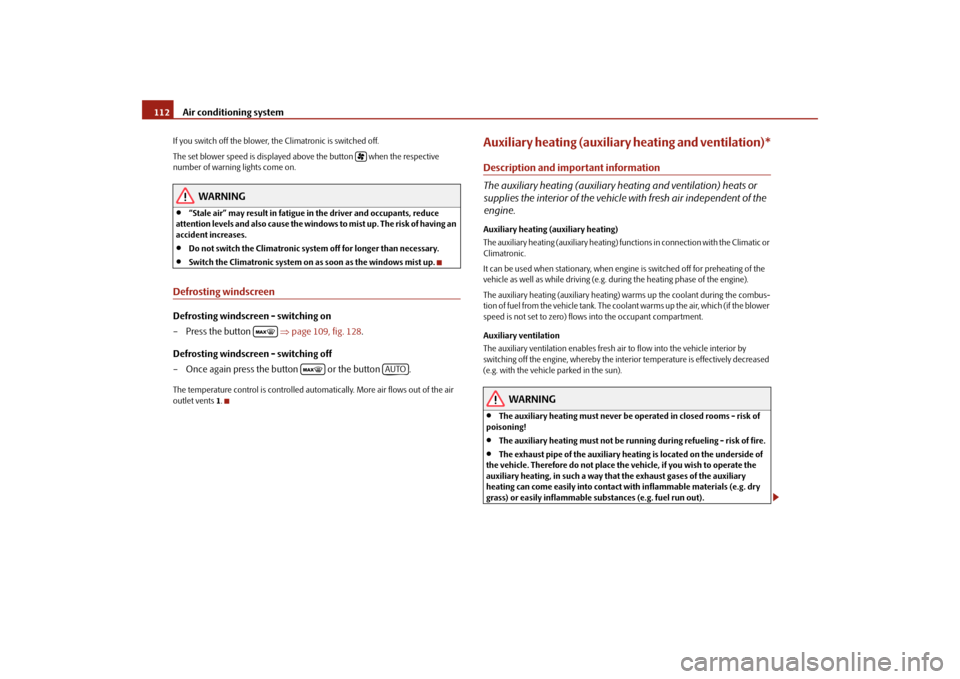
Air conditioning system
112
If you switch off the blower, the Climatronic is switched off. The set blower speed is displayed above the button when the respective number of warning lights come on.
WARNING
•
“Stale air” may result in fatigue in the driver and occupants, reduce
attention levels and also cause the windows to mist up. The risk of having an accident increases.•
Do not switch the Climatronic system off for longer than necessary.
•
Switch the Climatronic system on as soon as the windows mist up.
Defrosting windscreenDefrosting windscreen - switching on – Press the button
⇒
page 109, fig. 128
.
Defrosting windscreen - switching off – Once again press the butt
on or the button .
The temperature control is controlled automa
tically. More air flows out of the air
outlet vents
1.
Auxiliary heating (auxiliary heating and ventilation)*Description and important information The auxiliary heating (auxiliary heating and ventilation) heats or supplies the interior of the vehicle with fresh air independent of the engine.Auxiliary heating (auxiliary heating) The auxiliary heating (auxiliary heating) func
tions in connection with the Climatic or
Climatronic. It can be used when stationary, when engi
ne is switched off for preheating of the
vehicle as well as while driving (e.g. during the heating phase of the engine). The auxiliary heating (auxiliary heating)
warms up the coolant during the combus-
tion of fuel from the vehicle tank. The cool
ant warms up the air, which (if the blower
speed is not set to zero) flows
into the occupant compartment.
Auxiliary ve
ntilation
The auxiliary ventilation enables fresh air
to flow into the vehicle interior by
switching off the engine, whereby the interior temperature is effectively decreased (e.g. with the vehicle parked in the sun).
WARNING
•
The auxiliary heating must never be op
erated in closed rooms - risk of
poisoning!•
The auxiliary heating must not be runn
ing during refueling - risk of fire.
•
The exhaust pipe of the auxiliary heating is located on the underside of
the vehicle. Therefore do not place th
e vehicle, if you wish to operate the
auxiliary heating, in su
ch a way that the exhaust gases of the auxiliary
heating can come easily into contact
with inflammable materials (e.g. dry
grass) or easily inflammable su
bstances (e.g. fuel run out).
AUTO
s2dk.1.book Page 112 Wednesday, April 8, 2009 12:23 PM
Page 114 of 294
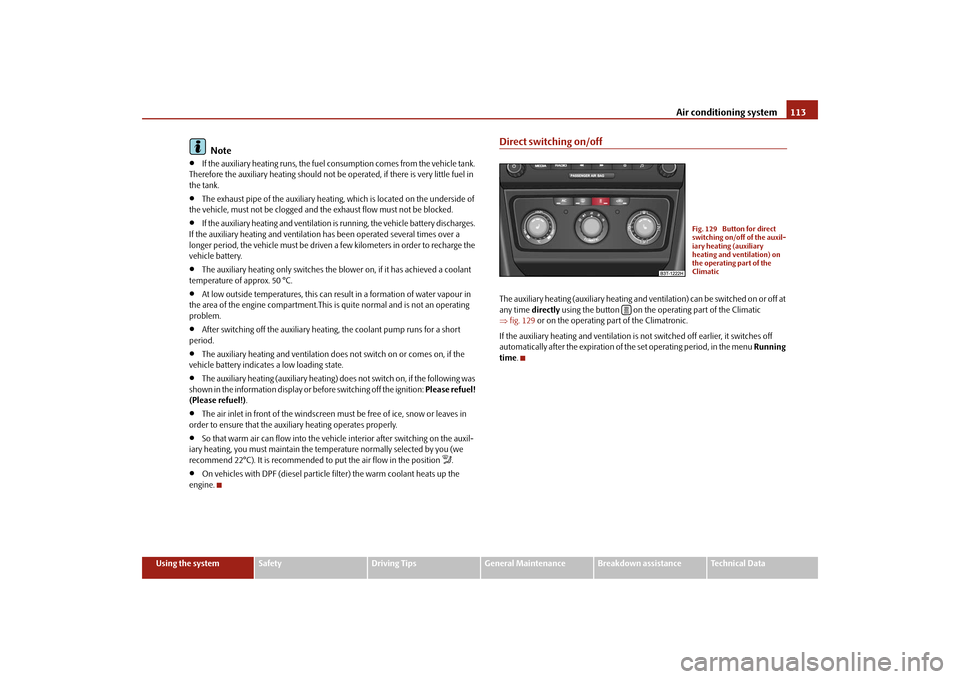
Air conditioning system
113
Using the system
Safety
Driving Tips
General Maintenance
Breakdown assistance
Technical Data
Note
•
If the auxiliary heating runs, the fuel
consumption comes from
the vehicle tank.
Therefore the auxiliary heating should not be operated, if there is very little fuel in the tank.•
The exhaust pipe of the auxiliary heating,
which is located on the underside of
the vehicle, must not be clogged and the exhaust flow must not be blocked.•
If the auxiliary heating and ventilation is
running, the vehicle battery discharges.
If the auxiliary heating and ventilation
has been operated several times over a
longer period, the vehicle must be driven
a few kilometers in order to recharge the
vehicle battery.•
The auxiliary heating only sw
itches the blower on, if
it has achieved a coolant
temperature of approx. 50 °C.•
At low outside temperatures, this can resu
lt in a formation of water vapour in
the area of the engine compartment.This
is quite normal and is not an operating
problem.•
After switching off the auxiliary heating, the coolant pump runs for a short
period.•
The auxiliary heating and ventilation does not switch on or comes on, if the
vehicle battery indicate
s a low loading state.
•
The auxiliary heating (auxiliary heating) does not switch on, if the following was
shown in the information display or before switching off the ignition:
Please refuel!
(Please refuel!)
.
•
The air inlet in front of the windscreen must be free of ice, snow or leaves in
order to ensure that the auxiliary heating operates properly.•
So that warm air can flow into the vehi
cle interior after switching on the auxil-
iary heating, you must maintain the te
mperature normally selected by you (we
recommend 22°C). It is recommended to
put the air flow
in the position
.
•
On vehicles with DPF (diesel particle filter) the warm coolant heats up the
engine.
Direct switching on/offThe auxiliary heating (auxiliary heating and ve
ntilation) can be switched on or off at
any time
directly
using the button on the op
erating part of the Climatic
⇒ fig. 129
or on the operating part of the Climatronic.
If the auxiliary heating and ventilation is not switched off earlier, it switches off automatically after the expiration of
the set operating period, in the menu
Running
time
.
Fig. 129 Button for direct switching on/off of the auxil-iary heating (auxiliary heating and ventilation) on the operating part of the Climatic
s2dk.1.book Page 113 Wednesday, April 8, 2009 12:23 PM
Page 115 of 294

Air conditioning system
114
Using the system So that the auxiliary heating (auxiliary heating and ventilation) func- tions according to your expectations, it is necessary to carry out the basic setting before its programming.Basic setting – On the information display, select from the
Main menu
the menu
point
Aux. heating
.
– In the menu
Aux. heating (auxiliary heating)
⇒
fig. 130
select the
menu point
Weekday
and set the current day.
– Return to a higher level by selecting the menu point
Back
, i. e. in the
menu
Aux. Heating (auxiliary heating)
.
–In the menu
Aux. Heating
select the menu point
Running time
and
set the desired operating period in steps of 5 minutes. The operating period can be 10 to 60 minutes.
– By selecting the menu point
Back
, you will reach in the menu
Aux. Heating (auxiliary heating)
.
– In the menu
Aux. heating (auxiliary heating)
select the menu point
Mode
.
– In the menu
Mode
select the desired mode
Heating
or
Ventilation
.
ProgrammingFor the programming of the auxiliary heatin
g (auxiliary heating and ventilation) in
the menu
Aux. heating (Aux. heating)
there are three pre-set times:
•
Pre-set time 1
•
Pre-set time 2
•
Pre-set time 3
In each pre-set time, the day and the time (hour and minute) can be set for switching on the auxiliary heating and/or ventilation. An empty position can be found between
Sunday and Monday when selecting the
day. If this empty position is selected,
the activation is performed without taking
into account the day. If you leave the pre-set menu by selecting the menu
Back
or do not operate the
display for longer than 10°seconds, the set values are stored, but the pre-set time is not active. Both other pre-set times can be programmed and stored in the same way.If you select the menu
Activate
after setting the desired values, appears on the
display
Pre-set time (weekday, hours, minute) activated! (Pre-set time
(weekday, hour, minute) activated!
and the set pre-set time is active.
Only one programmed pre-set time can be active.The last programmed pre-set time remains active.After the auxiliary heating activates at the set time, it is necessary to pre-set a time again. Changing the active pre-set time is carried out after selecting the menu point Activate
in the menu
Aux. heating (auxiliary heating)
by selecting a pre-set time.
The prerequisite for the correct switching
on of the auxiliary heating (auxiliary
heating and ventilation) according to th
e programmed pre-set time is the correct
setting of the current time and the weekday
⇒page 114.
Fig. 130 Information display: Aux. heating
s2dk.1.book Page 114 Wednesday, April 8, 2009 12:23 PM
Page 116 of 294

Air conditioning system
115
Using the system
Safety
Driving Tips
General Maintenance
Breakdown assistance
Technical Data
If the system is running, a warning light in
the button for direct switching on/off of
the auxiliary heating lights up. The running system deactivates after expiration of the operating period or is deac- tivated earlier by pressing the button for di
rect switching on/off of the auxiliary
heating
⇒page 113.
The random pre-set time can be deactivated by selecting the menu point
Deactive
in the menu
Activate
.
After selecting the menu point
Fac to r y s e tt ing
in the menu
Aux. heating
(auxiliary heating)
, it is possible to change to the factory setting.
Radio remote control The auxiliary heating (auxiliary heating and ventilation) can be switched on or off with the remote control.– For switching on, press the button . – For switching off, press the button .The transmitter and the battery are housed in the housing of the remote control. The receiver is located in
the interior of the car.
If the battery is properly charged, the ef
fective range is up to 600 m. For switching
on or off the auxiliary heating, hold the
remote control vertically with the antenna
⇒fig. 131
towards the top. You must not cover over the antenna with the
fingers or the palm of th
e hand. Obstacles between the radio remote control and
the vehicle, bad weather co
nditions and a weaker batt
ery can clearly reduce the
range. The auxiliary heating can only be switched
on or off with the radio remote control,
if the distance between the radio remote
control and the vehicle is at least 2 m.
Warning light in the radio remote control The warning light in the radio remote control
⇒fig. 131
indicates after a keystroke
if the remote control signal was received
by the auxiliary heating and if the battery
is adequately charged.
Caution
There are electronic components in the radio remote control, protect the remote control against water, severe
shocks and direct sun rays.
Fig. 131 Auxiliary heating: Radio remote control
ONOFF
AA
Display warning light
Importance
Lights up green for 2 seconds.
The auxiliary heating was switched on.
Lights up red for 2 seconds.
The auxiliary heating was switched off.
Slowly flashes green for 2 seconds.
The ignition signal was not received.
Quickly flashes green for 2 seconds.
The auxiliary heating is blocked, e. g because the tank is nearly empty or there is a fault in the auxiliary heating.
Flashes red for 2 seconds.
The switch off signal was not received.
Lights up orange for 2 seconds, then green or red.
The battery is weak, however the switching on or off signal was received.
Lights up orange for 2 seconds, then flashes green or red.
The battery is weak, however the switching on or off signal was not received.
Flashes orange for 5 seconds.
The battery is discharged, however the switching on or off signal was not received.
s2dk.1.book Page 115 Wednesday, April 8, 2009 12:23 PM
Page 117 of 294

Air conditioning system
116
Changing the battery of the radio remote controlIf the warning light of the radio remote control indicates a weak or discharged battery,
⇒
page 115, fig. 131
, it must be replaced. The battery
is located under a cover on the back of the radio remote control. – Place a coin into the gap of the batt
ry cover and by turning to the left,
unlock the cover.
– Change the battery, insert the cover and lock it by turning to the right.
For the sake of the environment
Dispose of an old battery in accord
ance with environmental regulations.
Note
•
Pay attention to the correct pola
rity when changing the battery.
•
The replacement battery must have the same specification as the original
battery.s2dk.1.book Page 116 Wednesday, April 8, 2009 12:23 PM
Page 118 of 294
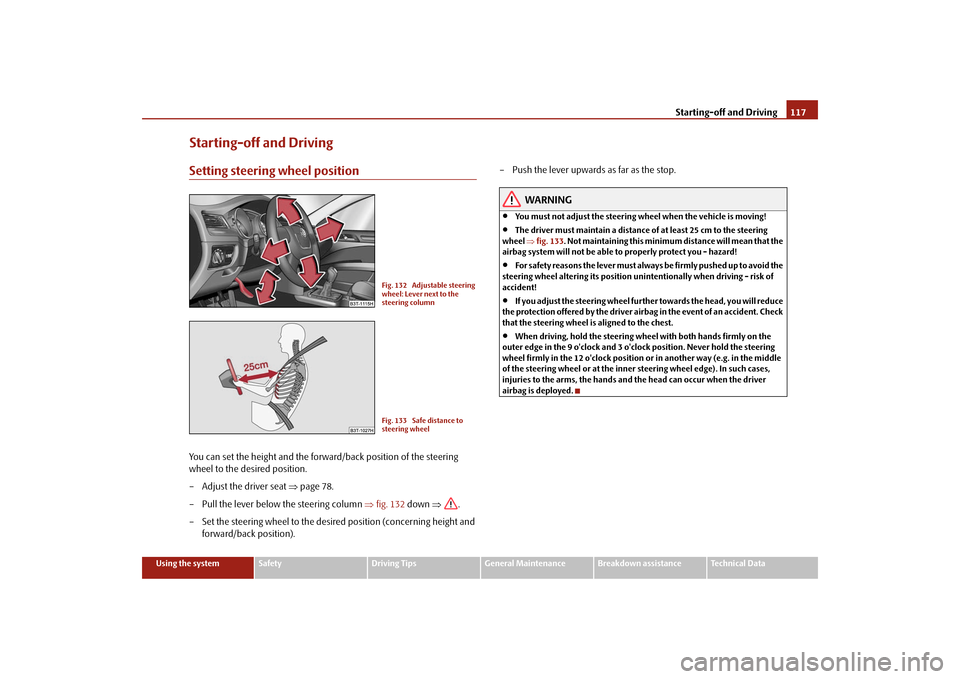
Starting-off and Driving
117
Using the system
Safety
Driving Tips
General Maintenance
Breakdown assistance
Technical Data
Starting-off and DrivingSetting steering wheel positionYou can set the height and the forw
ard/back position of the steering
wheel to the desired position. – Adjust the driver seat
⇒
page 78.
– Pull the lever below the steering column
⇒
fig. 132
down
⇒
.
– Set the steering wheel to the desired position (concerning height and
forward/back position).
– Push the lever upwards as far as the stop.
WARNING
•
You must not adjust the steering wh
eel when the vehicle is moving!
•
The driver must maintain a distance of at least 25 cm to the steering
wheel
⇒fig. 133
. Not maintaining this minimum distance will mean that the
airbag system will not be able to properly protect you - hazard!•
For s a fe t y re a s ons the le v e r m ust a lwa y s b e fi rm l y pus he d up t o a vo id the
steering wheel altering its position unintentionally when driving - risk of accident!•
If you adjust the steering wheel furthe
r towards the head, you will reduce
the protection offered by the driver airb
ag in the event of an accident. Check
that the steering wheel is aligned to the chest.•
When driving, hold the steering wheel
with both hands firmly on the
outer edge in the 9 o'clock and 3 o'clock position. Never hold the steering wheel firmly in the 12 o'clock position or in another way (e.g. in the middle of the steering wheel or
at the inner steering wheel edge). In such cases,
injuries to the arms, the hands and
the head can occur when the driver
airbag is deployed.
Fig. 132 Adjustable steering wheel: Lever next to the steering columnFig. 133 Safe distance to steering wheel
s2dk.1.book Page 117 Wednesday, April 8, 2009 12:23 PM
Page 119 of 294
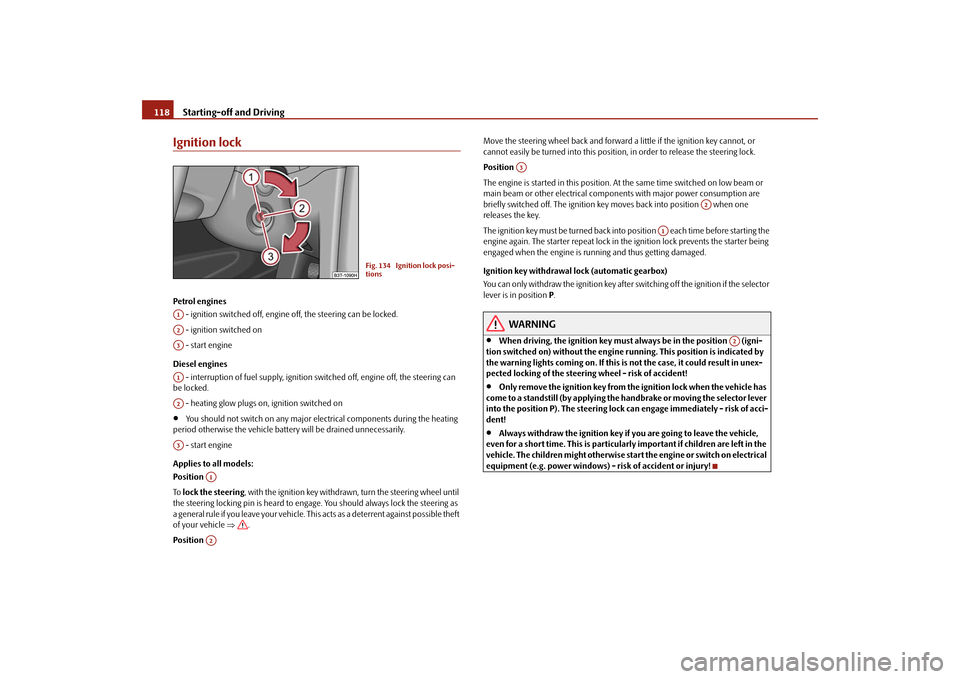
Starting-off and Driving
118
Ignition lockPetrol engines - ignition switched off, engine
off, the steering can be locked.
- ignition switched on - start engine Diesel engines - interruption of fuel supply, ignition sw
itched off, engine off, the steering can
be locked. - heating glow plugs on, ignition switched on•
You should not switch on any major elec
trical components during the heating
period otherwise the vehicle batt
ery will be drained unnecessarily.
- start engine Applies to all models: Position
To lock the steering
, with the ignition key withdrawn, turn the steering wheel until
the steering locking pin is heard to engage. You should always lock the steering as a general rule if you leave your
vehicle. This acts as a deterrent against possible theft
of your vehicle
⇒
.
Position
Move the steering wheel back and forward a little if the ignition key cannot, or cannot easily be turned into
this position, in order to
release the steering lock.
Position
The engine is started in this position. At
the same time switched on low beam or
main beam or other electrical compon
ents with major power consumption are
briefly switched off. The ignition key
moves back into position when one
releases the key. The ignition key must be turned back into position each time before starting the engine again. The starter repeat lock in th
e ignition lock prevents the starter being
engaged when the engine is r
unning and thus getting damaged.
Ignition key withdrawal lock (automatic gearbox) You can only withdraw the ignition key after switching off the ignition if the selector lever is in position
P.
WARNING
•
When driving, the ignition key must always be in the position (igni-
tion switched on) without the engine running. This position is indicated by the warning lights coming on. If this is not the case, it could result in unex- pected locking of the steerin
g wheel - risk of accident!
•
Only remove the ignition key from the ignition lock when the vehicle has
come to a standstill (by applying the handbrake or moving the selector lever into the position P). The steering lock
can engage immediately - risk of acci-
dent!•
Always withdraw the ignition key if
you are going to leave the vehicle,
even for a short time. This is particularly important if children are left in the vehicle. The children might
otherwise start the engine
or switch on electrical
equipment (e.g. power windows) - risk of accident or injury!
Fig. 134 Ignition lock posi- tions
A1A2A3A1A2A3
A1A2
A3
A2
A1
A2
s2dk.1.book Page 118 Wednesday, April 8, 2009 12:23 PM
Page 120 of 294
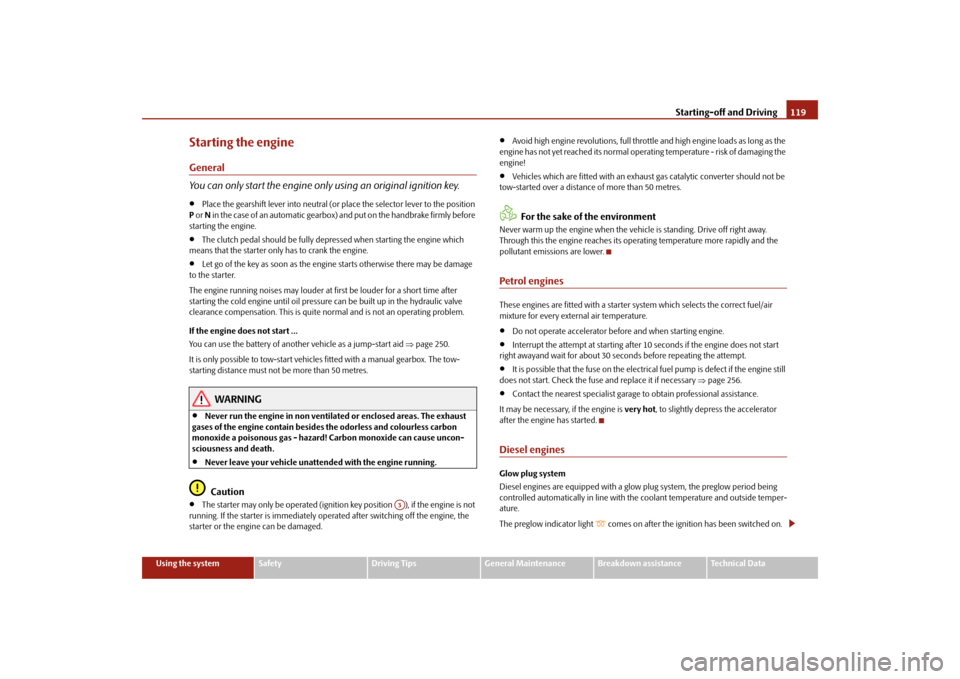
Starting-off and Driving
119
Using the system
Safety
Driving Tips
General Maintenance
Breakdown assistance
Technical Data
Starting the engineGeneral You can only start the engine only using an original ignition key.•
Place the gearshift lever into neutral (or place the selector lever to the position
P or N in the case of an automatic gearbox)
and put on the handbrake firmly before
starting the engine.•
The clutch pedal should be fully depressed when starting the engine which
means that the starter only
has to crank the engine.
•
Let go of the key as soon as the engine starts otherwise there may be damage
to the starter. The engine running noises may louder at
first be louder for
a short time after
starting the cold engine until oil pressure
can be built up in the hydraulic valve
clearance compensation. This is quite normal and is not an operating problem. If the engine does not start ... You can use the battery of anothe
r vehicle as a jump-start aid
⇒page 250.
It is only possible to tow-start vehicl
es fitted with a manual gearbox. The tow-
starting distance must not be more than 50 metres.
WARNING
•
Never run the engine in non ventilat
ed or enclosed areas. The exhaust
gases of the engine contain besides
the odorless and colourless carbon
monoxide a poisonous gas - hazard! Carbon monoxide can cause uncon- sciousness and death.•
Never leave your vehicle unattended with the engine running.Caution
•
The starter may only be operated (ignition key position ), if the engine is not
running. If the starter is immediately oper
ated after switching off the engine, the
starter or the engine can be damaged.
•
Avoid high engine revolutions, full throttl
e and high engine loads as long as the
engine has not yet reached it
s normal operating temperature - risk of damaging the
engine!•
Vehicles which are fitted wi
th an exhaust gas catalyti
c converter should not be
tow-started over a distance of more than 50 metres.
For the sake of the environment
Never warm up the engine when the vehi
cle is standing. Drive off right away.
Through this the engine reaches its operating temperature more rapidly and the pollutant emissions are lower.Petrol enginesThese engines are fitted with a starter system which selects the correct fuel/air mixture for every external air temperature.•
Do not operate accelerator before and when starting engine.
•
Interrupt the attempt at starting after
10 seconds if the engine does not start
right awayand wait for about 30 se
conds before repeating the attempt.
•
It is possible that the fuse on the electric
al fuel pump is defect if the engine still
does not start. Check the fuse and replace it if necessary
⇒page 256.
•
Contact the nearest specialist garage to obtain professional assistance.
It may be necessary, if the engine is
very hot
, to slightly depress the accelerator
after the engine has started.Diesel enginesGlow plug system Diesel engines are equipped with a glow
plug system, the preglow period being
controlled automatically in
line with the coolant temperature and outside temper-
ature. The preglow indicator light
comes on after the ignition has been switched on.
A3
s2dk.1.book Page 119 Wednesday, April 8, 2009 12:23 PM